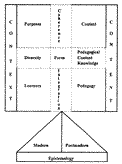|
|
the benefits of advance media -- digital libraries, multimedia curriculum design, and
wide-area networking. The idea of parents, children, teachers, and community
members joining together in educational activities is not new. It has been a difficult
ideal to realize. Networked technologies make it possible, through a single location,
to engage a diversity of people with learning scenarios, resources, and intellectual
tools. These information technologies make sustaining numerous different
educational functions ubiquitous. Using theses technologies can provide classroom
access to a network of consultants with special competencies, to undergraduate and
graduate students, and to professors who help field question that neither students
nor classroom teacher can answer through their independent inquiries.
I believethat information networks provide an infrastructure for changing
curriculum design. This is a shift away from questions of scope and sequences
towards questions of problem posing, project initiation, and facilitation of work
upon them. This implies redirecting assessment away from measuring how well
students know mandated minimums to disclosing their ability to manage inquiry
and solve problems. This curriculum design will encourage students to work in
small collaborative groups on challenging projects that take a significant period of
time to complete and cut across normal disciplinary boundaries. This curriculum
design makes it the responsibility of everyone in education -- students, teachers,
administrators and parents -- to be simultaneously both teacher and learner. This
curriculum design uses multimedia scenarios and projects that can appeal to diverse
learning styles and engage students of all backgrounds in cooperative, inquire-base
educations work. This curriculum design invites the pedagogy described by John
Dewey. The pedagogy itself involves various mentoring activities, helping to make
sure that students really grasp the problems and questions, that they comprehend
key characteristics of the data that they seek, and that they can use the tools of
analysis, simulation and synthesis purposefully. This is the pedagogy of research.
I believethat information networks is a representation of John Dewey's
postmodern Epistemology. Learning takes place in a social context. Knowledge is
created from information by action guided by pedagogy.
|
|


 1-2
3-4
5-6
7-8
9-10
11-12
13-14
15-16
17-18
1-2
3-4
5-6
7-8
9-10
11-12
13-14
15-16
17-18



 1-2
3-4
5-6
7-8
9-10
11-12
13-14
15-16
17-18
1-2
3-4
5-6
7-8
9-10
11-12
13-14
15-16
17-18

